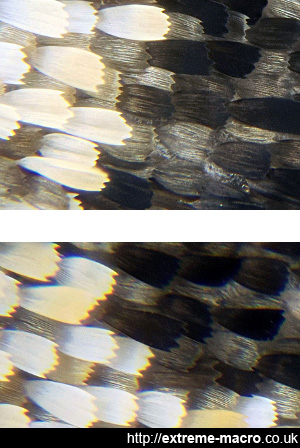Reichert 10x Objective
by Johan J Ingles-Le Nobel
Last updated August 31, 2017
Reichert is a company name that comes to us from another era; they produced a 10x finite objective that is not too difficult to find on eBay.
Finite objectives are microscope lenses that can be used for photography that do not require a tube lens and as such, a Reichert 10x is a tempting purchase for photographers.
Who Was Carl Reichert?
Carl Reichert married into the Leitz family in 1874 and began manufacturing in Vienna two years later. This, and the fact that he had some of the Leitz technicians working for him, explains why his instruments are very similar in design to those of Leitz.

Reichert 10x objective scales test on APSC. Not too awful in the centre (top) but soft and fringy in the corners (bottom).
Whilst you can correct for colour fringing using a lens correction filter in Photoshop - even using extreme settings for the sliders - and even better repeating the process because the sliders won't really go far enough - there is no real cure for the softness away from centre. Detail that is not there, is not there.
Reichert was known for high quality instruments well into the 20th century when it was eventually bought out by American Optical in 1962.
The Reichert In Action
The Reichert 10x objective is a finite objective designed to be used 150mm away from the sensor. On the upside, the working distance is outstanding, 12mm. It has an RMS thread.
This was an experimental purchase for me and it confirms many observations that can be made about using older finite objectives from eBay. I had heard good reports about this from others so I gave it a whirl.
The central resolution is good and definitely better than you'd obtain with a macro lens. However, the result is soft, and there is clear colour fringing away from the centre. For a first venture into extreme macro using microscope objectives it is about typical of what you can expect to get.
Correcting a Poor Objective
Whilst you can correct for colour fringing using a lens correction filter in Photoshop - even using extreme settings for the sliders - and even better repeating the process because the sliders won't really go far enough - there is no real cure for the softness away from centre. Detail that is not there, is not there.
That said, once you have dealt with the fringing as best you can, you can try things like apply a sharpening layer with a radially graded mask, so it is stronger at the edges. But at the end of the day the quality is limited and enthusiastic sharpening doesn't always give the most pleasing of images.
Increasing Extension?
The DIY lens hood
All you need to make a DIY lens hood for a microscope objective is a matt-black paper/card stock cylinder wrapped around the front of the objective. This will have a strong positive effect on the image quality of the final image, increasing contrast substantially.
An interesting experiment could be to increase the extension on the Reichert. The image circle should grow but you would also expect the centre to go softer. I don't know where that would happen, to an objectionable extent. Perhaps the sharper bits of the Reichert would cover the central square of a sensor at some magnification around 14x.
Thought processes like this is very much what extreme macro is about, and why it is rewarding. The manuals don't exist, and best results come from thinking out the box and finding a decent use for items that might not, at first sight, be obvious.
